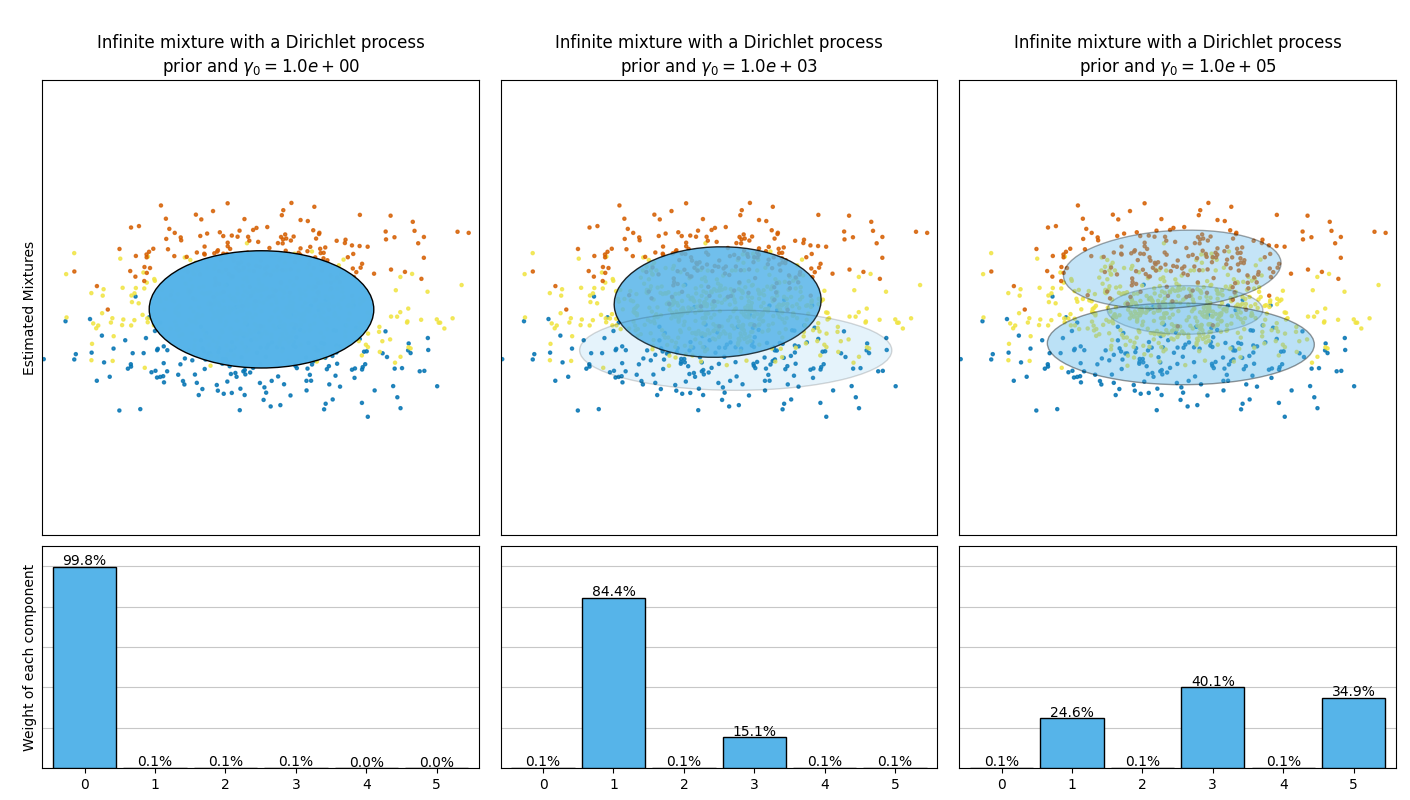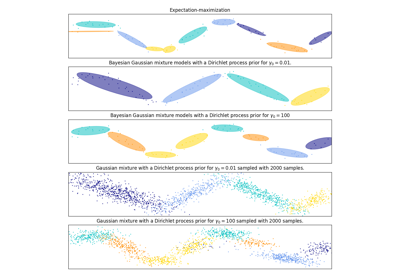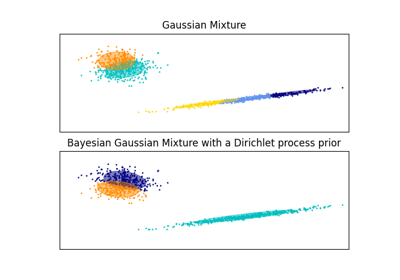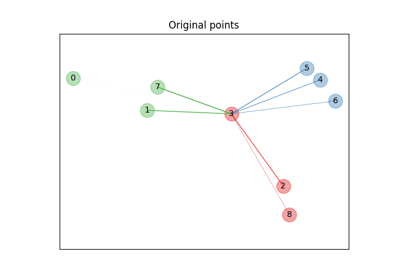备注
Go to the end 下载完整的示例代码。或者通过浏览器中的MysterLite或Binder运行此示例
变异Bayesian高斯混合物的浓度先验型分析#
此示例绘制了从玩具数据集(三个高斯的混合)中获得的椭圆体,该数据集由 BayesianGaussianMixture 一类Dirichlet分布先验模型 (weight_concentration_prior_type='dirichlet_distribution' )和Dirichlet过程之前 (weight_concentration_prior_type='dirichlet_process' ).在每张图上,我们绘制了之前重量浓度的三个不同值的结果。
的 BayesianGaussianMixture 类可以自动调整其混合成分的数量。参数 weight_concentration_prior 与所得到的具有非零权重的分量的数量有直接联系。如果浓度先验值较低,则模型会将大部分权重放在少数组分上,将其余组分的权重设置为非常接近于零。浓度先验的高值将允许更大数量的组分在混合物中具有活性。
Dirichlet流程previous允许定义无限数量的组件并自动选择正确数量的组件:仅在必要时才会激活组件。
相反,具有Dirichlet分布先验的经典有限混合模型将有利于更均匀的加权分量,因此倾向于将自然集群划分为不必要的子分量。
# Authors: The scikit-learn developers
# SPDX-License-Identifier: BSD-3-Clause
import matplotlib as mpl
import matplotlib.gridspec as gridspec
import matplotlib.pyplot as plt
import numpy as np
from sklearn.mixture import BayesianGaussianMixture
def plot_ellipses(ax, weights, means, covars):
for n in range(means.shape[0]):
eig_vals, eig_vecs = np.linalg.eigh(covars[n])
unit_eig_vec = eig_vecs[0] / np.linalg.norm(eig_vecs[0])
angle = np.arctan2(unit_eig_vec[1], unit_eig_vec[0])
# Ellipse needs degrees
angle = 180 * angle / np.pi
# eigenvector normalization
eig_vals = 2 * np.sqrt(2) * np.sqrt(eig_vals)
ell = mpl.patches.Ellipse(
means[n], eig_vals[0], eig_vals[1], angle=180 + angle, edgecolor="black"
)
ell.set_clip_box(ax.bbox)
ell.set_alpha(weights[n])
ell.set_facecolor("#56B4E9")
ax.add_artist(ell)
def plot_results(ax1, ax2, estimator, X, y, title, plot_title=False):
ax1.set_title(title)
ax1.scatter(X[:, 0], X[:, 1], s=5, marker="o", color=colors[y], alpha=0.8)
ax1.set_xlim(-2.0, 2.0)
ax1.set_ylim(-3.0, 3.0)
ax1.set_xticks(())
ax1.set_yticks(())
plot_ellipses(ax1, estimator.weights_, estimator.means_, estimator.covariances_)
ax2.get_xaxis().set_tick_params(direction="out")
ax2.yaxis.grid(True, alpha=0.7)
for k, w in enumerate(estimator.weights_):
ax2.bar(
k,
w,
width=0.9,
color="#56B4E9",
zorder=3,
align="center",
edgecolor="black",
)
ax2.text(k, w + 0.007, "%.1f%%" % (w * 100.0), horizontalalignment="center")
ax2.set_xlim(-0.6, 2 * n_components - 0.4)
ax2.set_ylim(0.0, 1.1)
ax2.tick_params(axis="y", which="both", left=False, right=False, labelleft=False)
ax2.tick_params(axis="x", which="both", top=False)
if plot_title:
ax1.set_ylabel("Estimated Mixtures")
ax2.set_ylabel("Weight of each component")
# Parameters of the dataset
random_state, n_components, n_features = 2, 3, 2
colors = np.array(["#0072B2", "#F0E442", "#D55E00"])
covars = np.array(
[[[0.7, 0.0], [0.0, 0.1]], [[0.5, 0.0], [0.0, 0.1]], [[0.5, 0.0], [0.0, 0.1]]]
)
samples = np.array([200, 500, 200])
means = np.array([[0.0, -0.70], [0.0, 0.0], [0.0, 0.70]])
# mean_precision_prior= 0.8 to minimize the influence of the prior
estimators = [
(
"Finite mixture with a Dirichlet distribution\n" r"prior and $\gamma_0=$",
BayesianGaussianMixture(
weight_concentration_prior_type="dirichlet_distribution",
n_components=2 * n_components,
reg_covar=0,
init_params="random",
max_iter=1500,
mean_precision_prior=0.8,
random_state=random_state,
),
[0.001, 1, 1000],
),
(
"Infinite mixture with a Dirichlet process\n" r"prior and $\gamma_0=$",
BayesianGaussianMixture(
weight_concentration_prior_type="dirichlet_process",
n_components=2 * n_components,
reg_covar=0,
init_params="random",
max_iter=1500,
mean_precision_prior=0.8,
random_state=random_state,
),
[1, 1000, 100000],
),
]
# Generate data
rng = np.random.RandomState(random_state)
X = np.vstack(
[
rng.multivariate_normal(means[j], covars[j], samples[j])
for j in range(n_components)
]
)
y = np.concatenate([np.full(samples[j], j, dtype=int) for j in range(n_components)])
# Plot results in two different figures
for title, estimator, concentrations_prior in estimators:
plt.figure(figsize=(4.7 * 3, 8))
plt.subplots_adjust(
bottom=0.04, top=0.90, hspace=0.05, wspace=0.05, left=0.03, right=0.99
)
gs = gridspec.GridSpec(3, len(concentrations_prior))
for k, concentration in enumerate(concentrations_prior):
estimator.weight_concentration_prior = concentration
estimator.fit(X)
plot_results(
plt.subplot(gs[0:2, k]),
plt.subplot(gs[2, k]),
estimator,
X,
y,
r"%s$%.1e$" % (title, concentration),
plot_title=k == 0,
)
plt.show()
Total running time of the script: (0分7.042秒)
相关实例
Gallery generated by Sphinx-Gallery <https://sphinx-gallery.github.io> _






